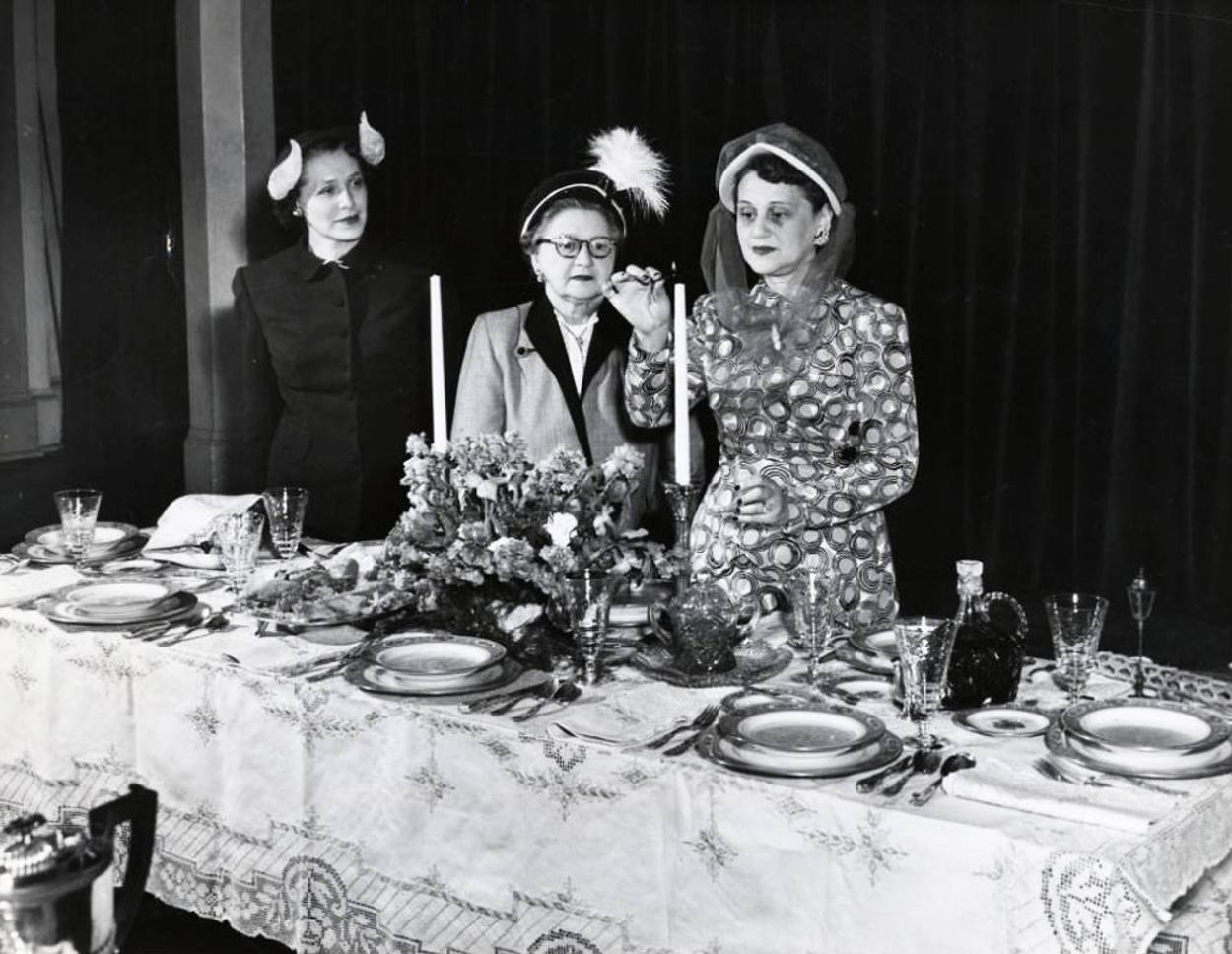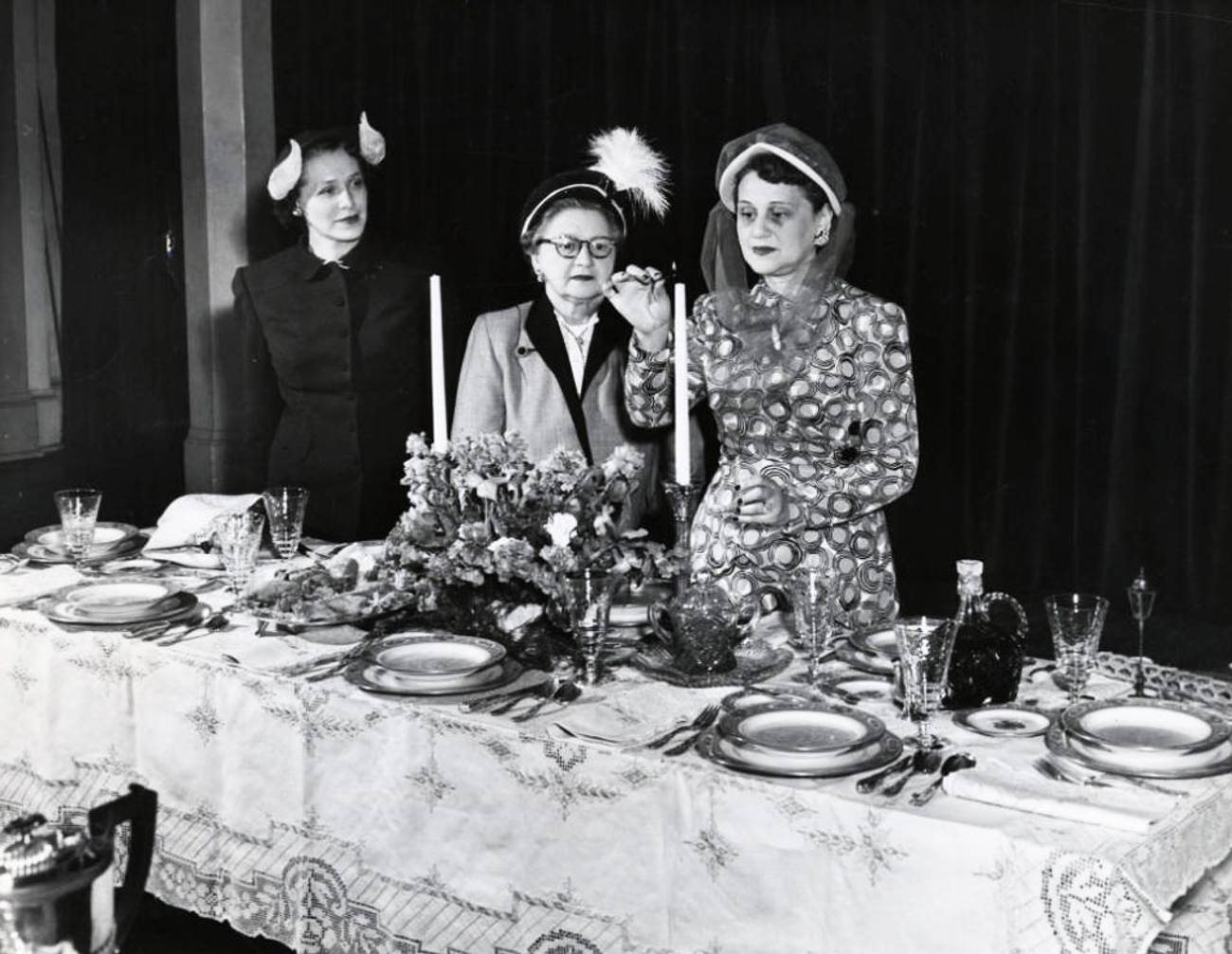‘The Jewess and the Synagogue’
The discussion about women’s roles in American synagogues began more than a century ago




Once upon a time, when American Jewish women were called—and called themselves—“Jewesses,” figuring out what Judaism meant to them and what they meant to Judaism was one of the pressing issues of the day. Throughout the late 19th and early 20th centuries, Jewish newspapers, for instance, were abuzz with editorials and feature articles about the relationship between “the Jewess and the synagogue,” or the “Jewess and Judaism,” especially as it played out on the street and within the sanctuary.
Much of this public discourse fastened on what it took to be the fairer sex’s seeming affinity for religion, a proclivity said to be born of both biology (the “womanly temperament”) and sociology (the “comparative monotony of her rounds”). Few American Jews, and fewer Americans, for that matter, doubted that women were far more predisposed than their menfolk to the contemplation of higher, and better, things.
Up for grabs, though, was how to make the most of that predisposition in a rapidly modernizing America. On that front, consensus gave way to confusion and even controversy. Some American Jews called for maintaining the status quo, insisting that it was the home and only the home that was, and should remain, the locus of Jewish women’s religiosity. Others advocated dismantling the status quo and making the synagogue the locus of Jewish women’s religious identity. Still others, seeking only the slightest adjustment to the existing landscape, were open to the possibility of charitable activity outside of the home, but not much else.
These days, the high-flying rhetoric that accompanied each of these positions makes for engaged reading; it might leave you cheering, cringing, or rolling your eyes. I’d like to think that it had a similarly galvanizing effect on readers more than a century ago when, say, in 1896, they happened upon an article in the Jewish Messenger calling on the synagogue to enlarge the Jewish woman’s opportunities for engagement. That institution “should not be satisfied in utilizing the services of the Jewess as decorator merely, but as builder and architect as well,” an editorial declared, adding that the Jewess “is ready for the synagogue and the synagogue must open its portals for the Jewess.”
Or perhaps, a decade later, when leafing through the pages of the American Israelite, readers took note of Rabbi Max Heller’s homily on the “delicate sex-division” within Judaism in which, said he, “woman is the preserver of religion, while man is its pioneer and shaper. Men hew out the paths; women are the makers of homes.” By the Reform rabbi’s lights, maintaining that distinction was key to the future of American Judaism, eliciting, one imagines, a bristling “harrumph” on the part of some of the newspaper’s more progressive female readers.
Back and forth it went, generating lively discussion and what one participant called “ventilation” and another “agitation.” Is it any wonder, then, that the pace of change was slow, incremental, and even tentative?
The first step toward enlarging the Jewish woman’s “sphere of usefulness” was to form and join a synagogue sisterhood of personal service, whose members attended to the needs of the Jewish poor. By clothing and feeding those on the margins, training them in the “arts of sewing and mending,” and introducing them to contemporary notions of hygiene and housekeeping, these “corps of visiting Jewesses” didn’t threaten the primacy of the home so much as augment its impact. They were doing what they had always done, but on a much larger and more public scale: Municipal housekeeping, it was called.
American Jewish women of the interwar years helped to combat what at the time was called the ‘indifference’ of their co-religionists.
Several decades later, amid the growing professionalization of social work, the sisterhood and with it, those Jewish women interested in doing more for themselves and their faith began actively to “cultivate the temple-going habit.” Attending Sabbath and holiday services increasingly became a priority. The object of sisterhood women, observed Mrs. Abraham Simon, president of the Federation of Temple Sisterhoods, in 1916 “is not so much to raise money as to raise Jews in loyalty, in dignity and in religious enthusiasm.” The most effective way to do just that, she claimed, was to “rally ’round the synagogue!”
Filling its pews, which otherwise were thinly populated, American Jewish women of the interwar years helped to combat what at the time was called the “indifference” of their co-religionists. Besides, now that they were increasingly “emancipated” from the upstairs ladies’ gallery to which they had once been consigned like “beautiful crockery ware,” and invited to sit downstairs, alongside their husband and children, they were able to enjoy and participate more fully in the proceedings, heightening the synagogue’s appeal.
Even when women continued to be housed upstairs and the system of separate seating kept intact, as was the case within Orthodox congregations throughout the land, at least the lattice work that had once occluded their view, rendering women invisible, had been taken down. Once a hallowed tradition, it came increasingly to be seen as a stumbling block, an old-fashioned practice that got in the way of Judaism’s integration into the modern body politic, and its abolition strongly encouraged. That “piece of ugly, contemptible medievalism,” the Jewish Chronicle of London hotly put it in an article reprinted in New York’s Jewish Messenger in 1877, “will have to go.”
Several years later, in 1881, the New York newspaper upped the ante by questioning why the “lattice work on the constitution” of modern-day synagogues had been retained, precluding the Jewish woman’s active participation in congregational affairs. “Why has the educated Jewess no voice in the synagogue, while every clerk or dry goods drummer can record his vote and be eligible to office?”
Advocating that some Jewish women be allowed to vote for members of the Sunday-school board and perhaps even be candidates themselves, the weekly anticipated opposition, even ridicule, among those Jewish leaders whose “idea of progress is Teutonic, not American.” It stood firm. So did growing numbers of other American Jews. Little by little, resistance to the notion of women as independent, voting members of a congregation softened, making room for their voice. “What remarkable change has been affected in woman’s position in the synagogue!” remarked the American Israelite a decade later. “How thoroughly Judaism has been occidentalized among us, the different estimate now placed on woman’s proper place and function is sufficient assurance.”
Even so, there were limits. The training of women as rabbis, much less opening the office of Parnass (synagogue president) “to the ladies,” was something else again. Nothing doing. Might a female rabbi be something American Jews should consider? “Certainly not,” the Jewish Messenger declared.
Others agreed. In 1897, the Reform Advocate, a Chicago Jewish newspaper, held what it loftily called a “symposium” on the subject of “woman in the synagogue.” Sending out questionnaires to a dozen prominent Jewish ladies, it elicited their opinion as to the communal role they might continue to play or assume in the future, like that of a female rabbi.
“Should a woman occupy the pulpit? Certainly,” declared Chicago social reformer Sadie American, especially if “she have [sic] the proper training and the native sympathy and spiritual insight, but only then. Let her not add to the number of unfit clergy.” Mary M. Cohen of Philadelphia agreed. “The woman who is fitted by nature and experience to occupy the pulpit, should do so. There is no sex in spirituality.”
Most of the respondents, however, were either hostile to the idea of a woman rabbi or hedged their bets. “Should woman occupy the pulpit?” “No—by all that is sacred—a hundred times no!” Katherine De Sola of Montreal responded passionately. “Let woman be as she has ever been, content to let men preach while she practices.” To which Esther Jane Ruskay of New York added that “a Jewish woman who has the best interests of her faith at heart has no desire to pose either as synagogue trustee, as deaconess, or high luminary of any sort. She knows she can best serve the interests of the synagogue by sending her husband and her sons there.”
Other respondents, among them New York social reformer Minnie Louis, hemmed and hawed when it came to the womanly demonstration of “pulpital power.” Woman, by her very nature, Louis believed, lacked the gift of oratory, and therefore might occupy the pulpit “as an occasional guest, yes; as a proprietress, no.” Expanding on her beliefs, Louis went on to state somewhat categorically, that “no age will produce Savonarolas, Beechers, or Hirschs of the feminine gender.”
It would take another 75 years before Louis’ pronouncement would be put to the test and women ordained as pulpit rabbis. In the meantime, the “religious equality of woman with man” emerged as a social good, or, better yet, as a value in its own right. Modern Judaism’s calling card, a testament to its alignment with modernity, it served as a litmus test on whether the age-old faith could more than hold its own as a modern phenomenon, or, alternatively, remain in thrall to the past. In its relationship to women, would Judaism cling to “Schulchan-aruchism,” as the American Israelite evocatively put it, or prove itself “worthy of the age in which we live?”
The answer stares us in the face. All we have to do is to look around the contemporary synagogue sanctuary where women figure, and even predominate, as rabbis, cantors, prayer leaders, Torah readers, and congregants.
Jenna Weissman Joselit, the Charles E. Smith Professor of Judaic Studies & Professor of History at the George Washington University, is currently at work on a biography of Mordecai M. Kaplan.